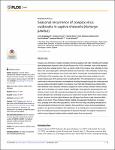Seasonal recurrence of cowpox virus outbreaks in captive cheetahs (Acinonyx jubatus)
Stagegaard, Julia
Kurth, Andreas
Stern, Daniel
Dabrowski, Piotr Wojciech
Pocknell, Ann
Nitsche, Andreas
Schrick, Livia
Cowpox virus infections in captive cheetahs (Acinonyx jubatus) with high morbidity and mortality have already been reported in the UK and Russia in the 1970s. However, most of the reported cases have been singular events. Here, we report a total of five cowpox virus outbreaks in cheetahs in the same safari park in Denmark between 2010 and 2014. Nine cheetahs showed varying severity of clinical disease; two of them died (22%). All episodes occurred between August and October of the respective year. No other carnivores kept at the same institution nor the keepers taking care of the animals were clinically affected. The clinical picture of cowpox was confirmed by extensive laboratory investigations including histopathological and molecular analyses as well as cell culture isolation of a cowpox virus. High anti-orthopoxvirus antibody titers were detected in all 9 diseased cheetahs compared to seven contact cheetahs without clinical signs and 13 cheetahs not in direct contact. Additionally, whole genome sequencing from one sample of each cluster with subsequent phylogenetic analysis showed that the viruses from different outbreaks have individual sequences but clearly form a clade distinct from other cowpox viruses. However, the intra-clade distances are still larger than those usually observed within clades of one event. These findings indicate multiple and separate introductions of cowpox virus, probably from wild rodent populations, where the virus keeps circulating naturally and is only sporadically introduced into the cheetahs. Sero-positivity of voles (Arvicola amphibious) caught in zoo grounds strengthens this hypothesis. As a consequence, recommendations are given for medical and physical management of diseased cheetahs, for hygienic measures as well as for pre-shipment isolation before cheetah export from zoo grounds.
Dateien zu dieser Publikation
Keine Lizenzangabe

